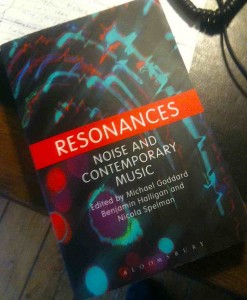 So pleased to have a chapter in this new collection, edited by my Salford colleagues Drs Michael Goddard, Ben Halligan and Nicola Spelman. The book originates in a conference Ben and Michael organised at Salford a couple of years ago, Bigger Than Words, Louder Than Pictures: Noise, Affect, Politics. In fact Resonances is a companion volume to the already-published Reverberations: The Philosophy, Aesthetics and Politics of Noise (Bloomsbury, 2012), so Bigger Than Words really was a tremendously productive conference.
So pleased to have a chapter in this new collection, edited by my Salford colleagues Drs Michael Goddard, Ben Halligan and Nicola Spelman. The book originates in a conference Ben and Michael organised at Salford a couple of years ago, Bigger Than Words, Louder Than Pictures: Noise, Affect, Politics. In fact Resonances is a companion volume to the already-published Reverberations: The Philosophy, Aesthetics and Politics of Noise (Bloomsbury, 2012), so Bigger Than Words really was a tremendously productive conference.
As the editors explain in their introduction, the book’s 19 chapters cover ‘a range of contemporary music (post-classical, improvisatory, psychedelic, [post-]punk, industrial and noise music proper)’, though my own chapter is at the uncool or derrière-garde music end of things; more Slade and Ted Nugent than My Bloody Valentine or, er, Filthy Turd. But my piece is really exploring the way a cultural form can function as a disabling experience, that springs from Pete Townshend of The Who’s plaintive confession in 2006 that ‘I have unwittingly helped to invent and refine a type of music that makes its principal proponents deaf’. Here’s an extract:
[In other writings] I have explored ways in which the relation between popular music and disability is a positive, enhancing or empowering one, regardless of how complicated that might sometimes appear. So, for example, the repertoire of popular music lyrics includes the representation of the experiences of being disabled, its singing voices mark a connection with the extraordinary body, its bodies themselves find affirming space in the culture and performance of freakdom or deviance that some pops and subcultures have innovated, and sometimes its musical forms are capable of denoting a physical difference. In ways like these, even while we may be surprised by the generous fact, the culture can include the marginalised disabled.
But we need also to consider situations in which popular music can function as a disabling culture. What should strike us is the extent to which some consumption and production practices in pop and rock have begun consistently to contribute to an experience of disability. Varieties and degrees of hearing impairment, tinnitus, difficulty with the auditory discrimination of simultaneous sounds, and deafness figure prominently here. Pop crips. It really can.
This chapter draws on some of the material from a much longer discussion of hearing impairment and music in Shakin’ All Over: Popular Music and Disability. Further information about Resonances is available here.
